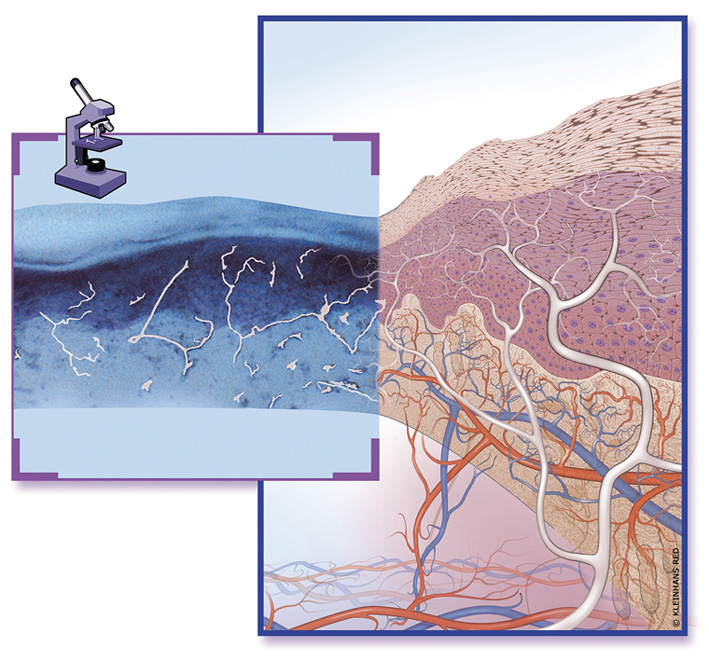The cutaneous nervous network

Human skin is characterized by a complex network of nervous fibers which extends from the subcutaneous fatty tissue through the corium to the uppermost living layers of the epidermis. In our illustration, which shows a schematic cross-section through the skin, the nerves are shown in white.
In the microscopic section of the illustration the light tissue of the papillary dermis lies directly underneath the basal membrane with special nervous endings, lymph vessels and the capillaries of the densely organized blood vessel system. This serves to supply the epidermis which is free of vessels, i.e. only the basal membrane is -- in contrast to the nervous fibers --not interrupted by vessels. The ramifications of the nerves and the nervous endings in the epidermis may only be visualized by special coloration.
Over one million sensory bodies are distributed in the human skin. Major sensors are the Vater-Pacinian corpuscules in the subcutaneous tissue area which perceive vibrations and Meissner's touch corpuscules or touch discs on the epidermal-dermal border. They are receptors for touch. Further well-developed sense organs in the dermis are the corpuscules of Ruffini (receptors for expansion) as well as the Krause end bulbs (mechanoreceptors). Intraepithelial nerve endings are sensitive nerve fibers in the skin which release perceptions of warmth, cold, pain, touch and pressure.
Since the skin has a major function as an organ of perception and interaction, the cutaneous nerves are in constant communication with the brain and the environment. These major structures of the skin may regulate the immune system and may be involved in skin inflammations. The sensoric or cerebrospinal nerves perceive such external and internal skin stimuli such as touch, tension, pain and cold. The autonomous or vegetative nerves control the vessels, the integumentary system and the unstriped muscles, as well as the piloerection of the hair of the skin.
Source: Kosmetik - Entwicklung, Herstellung und Anwendung kosmetischer Mittel, ed. Wilfried Umbach, 2. Auflage, Georg Thieme Verlag 1995. http://www.urmc.rochester.edu/neuroslides02/slide29.html
